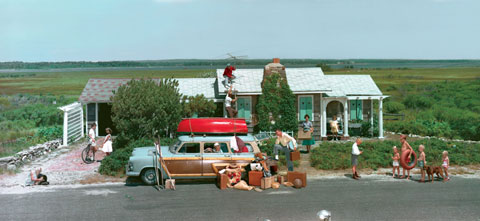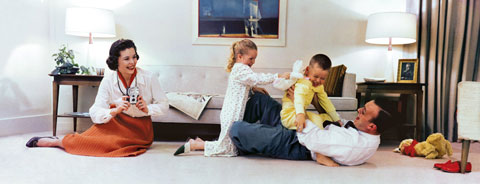
Kodak–I wrote with sadness a few weeks ago about the news that the company had filed for bankruptcy. Recently, the blogs have been featuring old Kodak Coloramas, the giant back-lit transparencies that were used to promote picture taking by the masses. Occasionally the images were impressive, but mostly they were kitschy, saccharine views of American life. We like them now–as parody–but even at the time they were unhip and projected an image of a company hopelessly out of step with a growing younger generation of amateur and erstwhile professional photographers. The writing was on the wall as early as the 1970s.
When I entered art school in 1977, Kodak was relevant to me primarily for their film, paper, and chemistry. By then, the Japanese had already cornered the serious camera market. Nikon, Canon, and a host of others were making beautifully designed SLRs and rangefinder 35mm cameras. My first camera was Nikkormat. Leica was still the premier street photographer’s camera, and although I couldn’t afford one, I did buy German-made lenses (Rodenstock and Schneider) when I got my first view camera. Kodak cameras were dumbed down gadgets for Mom and Dad who somehow always photographed you with a tree sticking out of your head.
Not that it mattered much–film was the core of Kodak’s business.
But even there, the company blew it spectacularly. Here’s how it went for me:
In the ’80s photographers began moving away from slide film, at that time dominated by Kodak, especially with their most famous brand Kodachrome. I began shooting negative film for making prints, and all my art projects were done that way. But my architectural clients wanted 4×5 transparencies, and the magazines, printed primarily in color, wanted the same.
In the mid or late 1980s 4×5 holders gave way to paper packets that did not require hand loading, which vanquished the dust problem that plagued sheet film. Fuji’s product had one sheet per packet and Kodak two. I typically shot six sheets of film for each image–two normals, and two at 1/2 stop under and over. The lab I used hated the 2-sheet Kodak packages because they had difficult time keeping track of the film, and I was strongly urged to use Fujifilm. Not only that, 2-sheet packs were more difficult to handle and more prone to accidents in the field, which would then spoil two images.
At some point I actually decided to track down someone at Kodak and explain to them how quickly they were losing New York professionals–a small number of people compared to the tens of thousands of wedding and portrait photographers around the world–but certainly their most prestigious and important group of customers. After being shunted from one department to another, I finally spoke to someone in Rochester involved in the manufacture of sheet film. He claimed that the 2-sheet packaging was what their customers wanted. He was friendly, but clearly did not understand the alarm I was raising. Way too late, a few years later, Kodak ditched the 2-sheet packaging.
One of the great challenges in shooting architectural interiors in those days was balancing different sources of light, and increasingly, fluorescent lighting was used in offices mixed with incandescents spots. Fluorescents, as you still see in older color pictures, came out an insipid green on film. Elaborate schemes involving multiple exposures, gelled fixtures, and filters, were used to achieve the desired natural look. As a result, architectural photographers comprised an elite priesthood performing small lighting miracles with their bag of tricks.
And then the final straw. I can’t pinpoint the year, but I believe it was in the early ’90s, Fujifilm introduced a negative film that came embedded with an extra layer designed to neutralize the green cast of fluorescents. This invention altered architectural photography immediately and permanently, and Kodak would have no answer for years. Virtually every interiors photographer abandoned Kodak for good.
From today’s Times:
Through the 1990s, Kodak spent some $4 billion developing the photo technology inside most of today’s cellphones and digital devices. But a reluctance to ease its heavy financial reliance on film allowed rivals like Canon and the Sony Corporation to rush into the fast-emerging digital arena. The immensely lucrative analog business Kodak worried about undermining was virtually erased in a decade by the filmless photography it had invented.
I just cringe reading this. They invented the technology of the future but utterly failed to create products that appealed to a new generation of customers. What an epic failure by one of America’s great companies.
Kodak considers home photo printers, high-speed commercial inkjet presses, workflow software and packaging to be the core of its future business. Since 2005, the company has poured hundreds of millions of dollars into new lines of inkjet printers. Once the digital camera business is phased out, Kodak said its consumer business would focus on printing.
Just in case anyone from Kodak is reading this, you’ve already lost this market to HP, Epson, and Canon. It’s over. The seeds of this failure go all the way back to those now beloved Coloramas. Kodak’s managers and marketers were lost in a rapidly vanishing American landscape–an imagineer’s Disneyland America–not the real world, not the changing world. Not the high tech world that Steve Jobs and other entrepreneurs here and abroad understood and so effectively exploited.
R.I.P. Kodak. (please keep making 4×5 negative film and c-print paper for me just a little longer)

